Yellow Flowering Lawn Weeds: Identification and Control (with Pictures)
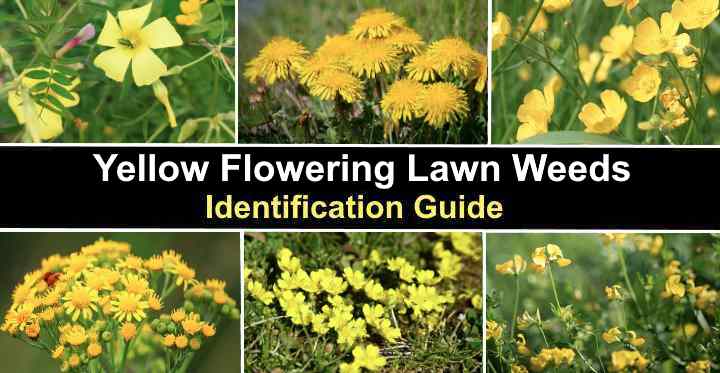
Yellow-flowering lawn weeds can make maintaining a beautiful garden challenging. The weedy plants with yellow flowers can affect the aesthetic beauty of your lush turfgrass. Also, with their invasive growth, the yellow weeds can drain the soil of nutrients and take over your beautiful green lawn. And it seems that certain yellow-flowering weeds have the uncanny ability to appear without warning after a rain shower.
Unfortunately, eradicating your lawn from invasive yellow flowers is tricky. Weedy growth means that some plants with creeping stems, like buttercups and creeping cinquefoil, have extensive underground root systems, making them difficult to remove completely. Or other yellow weeds, like the notorious dandelion, have thick, deep taproots with fibrous secondary roots spreading in all directions.
Do you want to get rid of yellow weeds from your lawn? If so, the first step is identifying the type of yellow-flowering plants growing in your yard. Then you can know the best ways to eliminate the yellow flowers and restore your beautiful lawn to its former lush glory.
The article is a complete guide to identifying weeds with yellow flowers that commonly grow in lawns.
What Are Lawn Weeds with Yellow Flowers?
Yellow-flowering lawn weeds are plants growing in your lawn where you don’t want them.
Common characteristics of weedy turfgrass plants are their creeping growth via stolons that root in the soil, or thousands of seeds that seem to germinate anywhere. Although many yellow flowering plants are useful for landscaping, they become weeds when they grow where you don’t want them.
How to Identify Yellow Flowering Lawn Weeds
The easiest way to recognize the species of weedy plant is to examine the flowers, leaf shape, and growth habits. For example, some yellow weeds have flowering clusters in an umbrella (umbels) shape, and others have fuzzy flowers growing at the end of stems. In contrast, other weeds have golden-yellow flowers growing along spreading stolons.
For example, dandelions tend to have lobed, slender leaves growing in a flattened rosette pattern with bright yellow flowers on tubular stems. Weeds like dandelion, woodsorrel and common groundsel have taproots. However, yellow weeds like buttercup, birdsfoot, and creeping cinquefoil have small yellow flowers with creeping stems and prostrate growth.
How to Eradicate Yellow Weeds From Grass
Eliminating yellow weeds from a grassy lawn can be problematic. Usually, the easiest way to get rid of the lawn weed is to remove the plant as soon as it appears. Depending on the type of weed, you may have to dig out as much of the root as possible. Also, removing stems before they bloom will prevent hundreds of seeds from dispersing in the wind.
Another natural control method for yellow lawn weeds is to apply a pre-emergent herbicide in spring. For example, corn gluten meal applied to the lawn in February or March can help to prevent weedy plants from taking root.
Additionally, keeping your lawn healthy is the number one way to avoid weeds in your lawn. For example, letting the grass grow slightly longer prevents weeds from germinating. Also, a balanced lawn fertilizer with nitrogen, phosphorus, and potassium keeps turfgrass thick, thus not giving weeds room to grow.
In extreme cases where weeds have taken over your lawn, you may need to apply a broadleaf herbicide. However, these post-emergent herbicides typically contain potentially toxic chemicals that can harm the health of pollinators and beneficial insects.
Related reading: The best homemade natural weed killers.
Common Lawn Weeds with Yellow Flowers
The most common yellow-flowering lawn weeds are yellow sweetclover, purslane, yellow sorrel, and buttercups. Some lawn weeds with yellow flowers that are difficult to eradicate are dandelion, capeweed, and black medic. However, dandelions come out on top of all the lawn weeds that are most prevalent and difficult to eliminate.
Types of Lawn Weeds with Yellow Flowers (with Pictures)
Let’s look in detail at the identification features of common lawn weeds with yellow flowers.
Creeping Buttercup (Ranunculus repens)
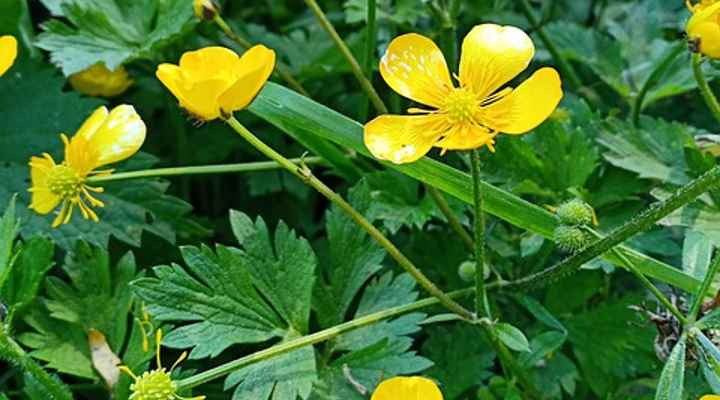
Creeping buttercup is a fast growing yellow flowering ground cover plant that can become a grass weed
Creeping buttercup is a pesky yellow-flowering lawn weed that can quickly take over a beautiful lawn. Small yellow flowers bloom in late spring, and the creeping stolons have parsley-like three-toothed leaves. Buttercups spread rapidly from seeds or fast-growing stems that root in turfgrass at the nodes.
Identifying features of buttercups are their short stems, toothed leaflets, and small golden yellow flowers. Buttercup is such a prolific lawn weed that a single plant can spread up to 40 sq. ft. (3.7 m2). Creeping buttercup grows 8” to 12” (10 – 15 cm) tall and 36” (91 cm) wide.
How to control creeping buttercup
The best way to control creeping buttercup is to keep your lawn healthy and thick. Additionally, removing any weeds with the roots in springtime will help limit their growth and prevent the weedy plants from spreading seeds in the wind.
Dandelion (Taraxacum officinale)
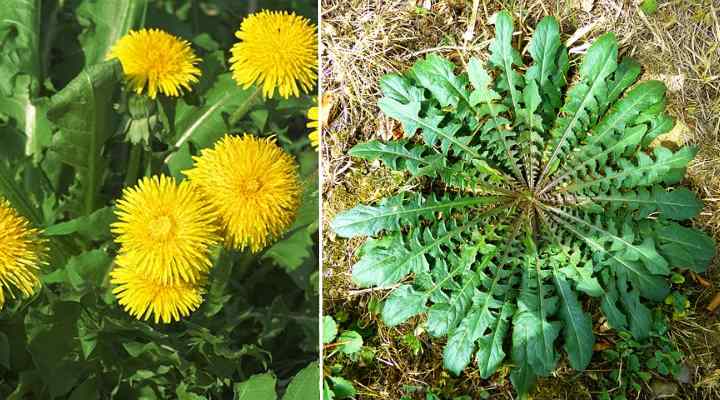
The yellow flowering dandelion weed is a common sight in grass plots and has a deep taproot
Dandelion is one of the most detested lawn weeds with yellow flowers. Identifying features of dandelion are its deeply-notched oblong edible leaves and bright yellow flowers growing solitary on green-reddish stems. In addition, dandelion is an opportunistic flowering weed plant that thrives in any soil type, especially rich, fertile soil.
Dandelion emerges in lawns as small lance-shaped, lobed, toothed leaves growing in a rosette pattern. The yellow flowers emerge in spring but can bloom throughout the year. In the fall, dandelion flowers turn to a characteristic globe-shaped head with a fluffy appearance due to numerous feathery seeds—up to 20,000 per plant.
How to control yellow-flowering dandelion weeds
Dandelion is tricky to remove because it has a deep taproot up to 3 ft. (1 m) long. However, you can use a dandelion digger to remove as much of the long fibrous root as possible. Additionally, encouraging your lawn to grow thick and healthy foliage will prevent the pesky yellow weeds from growing in the first place.
Yellow Woodsorrel (Oxalis stricta)
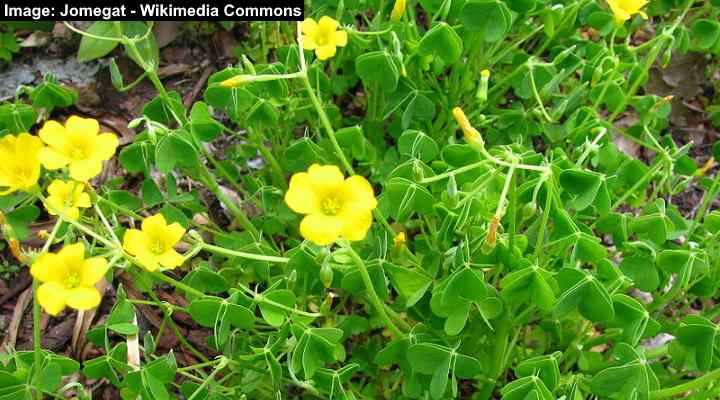
Yellow woodsorrel weed can be identified by its small yellow flowers and distinctive heart-shaped leaves
Yellow sorrel is a ground-hugging lawn weed that has small yellow trumpet-shaped flowers. An easily identifying feature of yellow woodsorrel is its distinctive leaves consisting of three heart-shaped leaflets. The brightly colored yellow flowers have five petals that bloom in summer and early fall. Creeping sorrel grows 6” to 20” (15 – 50 cm) tall.
Also called sourgrass, yellow woodsorrel spreads by a long taproot, underground rhizomes, and seed dispersal. After flowering, upright hairy seed capsules appear that split and shoot brown teardrop-shaped seeds several feet away.
Some varieties of low-growing sorrel plants are also purple-flowering lawn weeds.
How to control yellow woodsorrel
An effective pre-emergent herbicide like corn gluten meal in spring can help prevent the weeds from growing. Additionally, removing the plant when the soil is moist and before seed capsules develop can help prevent its spread. Like most lawn weeds, prevention starts with keeping your turfgrass lush and healthy with a thick layer of foliage.
Purslane (Portulaca oleracea)
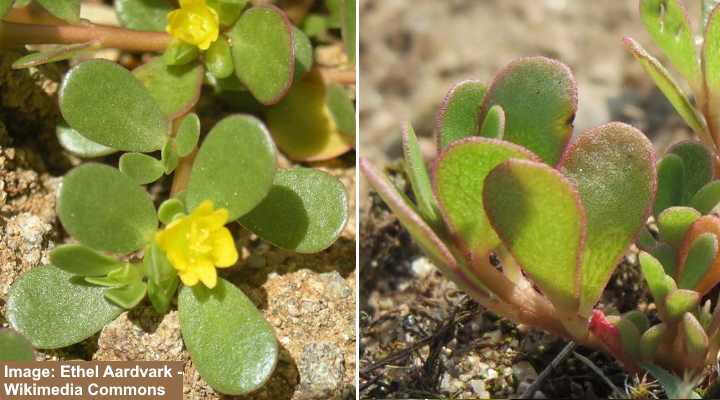
Purslane spreads quickly in the grass and looks like small yellow flowers with rounded thick leaves
Purslane is a common lawn weed with tiny yellow flowers and fleshy succulent leaves. The yellow flowers on this weed are five-petalled cup-shaped blooms. These little flowers contrast nicely with the spoon-shaped to oval leaves growing on reddish stems. Purslane grows quickly in the summertime heat and readily self-seeds.
Purslane can take over a lawn by spreading through seeds and trailing stems that root wherever they contact the soil. The annoying yellow lawn weed grows 3” (7.5 cm) tall and up to 18“ ( 45 cm) wide.
You can also grow purslane in a landscape as yellow-flowering ground cover for full sun.
How to control purslane
The best way to eradicate purslane is to remove the succulent weeds from the ground by the roots before flowers appear. Weeding is straightforward as the trailing stems lift easily from the ground.
Butterweed (Packera glabella)
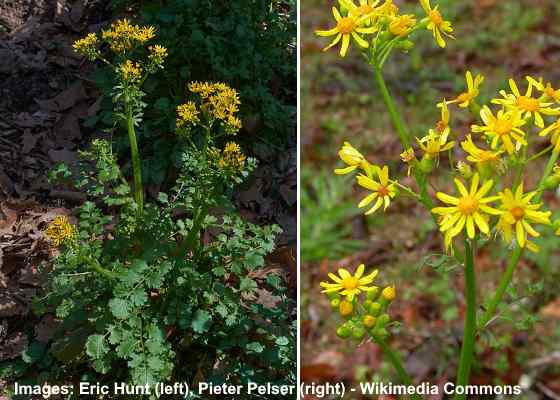
Butterweed is a tall weed with yellow flowers that grow in lawns and grassy areas
Butterweed is a common lawn weed with yellow flowers found in the southeastern United States. The weed’s buttery-yellow daisy-like flowers have 5 to 15 petals forming a ray around a central disk. Clusters of these small yellow flowers grow at the top of tall stems. Its small toothed leaves grow in a rosette pattern.
Like other yellow weeds that spread via seeds, the flowers turn to a white feathery pappus—fluffy tufts of white hair. The yellow-flowering stalks can grow 3 ft. (1 m) tall. This yellow weed can be found growing in fields, gardens, and other disturbed areas.
How to control butterweed
Like most weeds that infest grassy areas in a landscape, swift removal of young butterweed plants is vital to control their growth and prevent it from spreading.
Creeping Cinquefoil (Potentilla reptans)
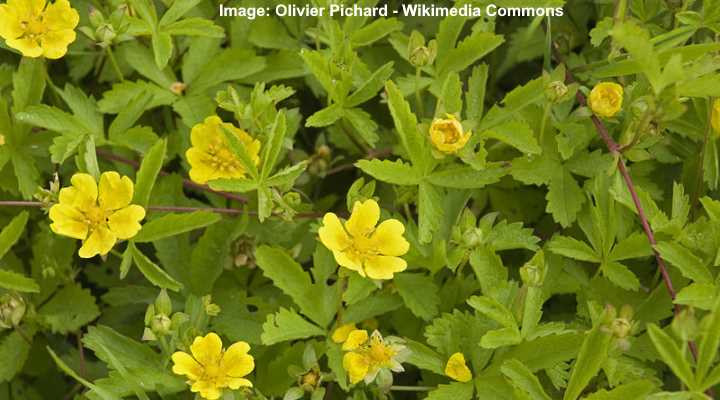
The yellow flowering creeping cinquefoil can affect grass and lawns and become a weed with its spreading nature
Creeping cinquefoil is a creeping lawn weed that can be difficult to eliminate once it has invaded your lawn. This perennial weed is identified by its bright five-petalled yellow flowers, obovate serrated leaves growing in groups of five to seven leaflets, and low growth.
As a common pesky yellow weed, creeping cinquefoil typically takes root in neglected turfgrass or lawns with poor soil. The noxious weed spreads via creeping stems that grow up to 3 ft. (1 m) long, rooting at leaf nodes in soil.
How to control creeping cinquefoil
To get rid of yellow cinquefoil weeds easily, water the lawn two days before you plan on weeding your lawn. Moist soil makes it easier to remove the entire taproot and prevent regrowth.
Common Groundsel (Senecio vulgaris)
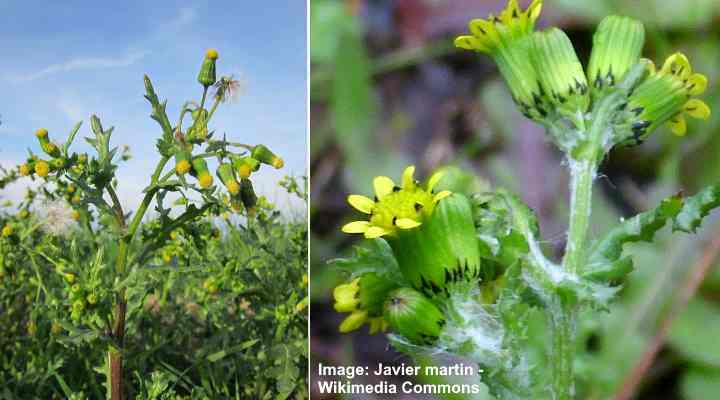
Common groundsel weed can grow quite tall in the grass and has clusters of small yellow flowers and shallow roots
Common groundsel is a lawn weed with yellow flowers that thrives in turf. This garden weed has small yellow dandelion-like flower heads that look like small tufts of yellow velvet. The weed’s leaves are deeply lobed and look like hedge cutter blades. If left to thrive, the branched stems grow 18” (45 cm) tall.
Common groundsel has shallow roots with a small taproot and secondary fibrous roots. This annual weed spreads by its weed seeds, and new plants tend to appear in lawns in springtime.
How to control common groundsel
For effective eradication from lawns, remove groundsel by hand before the fast-growing weed can flower.
Birdsfoot Trefoil (Lotus corniculatus)
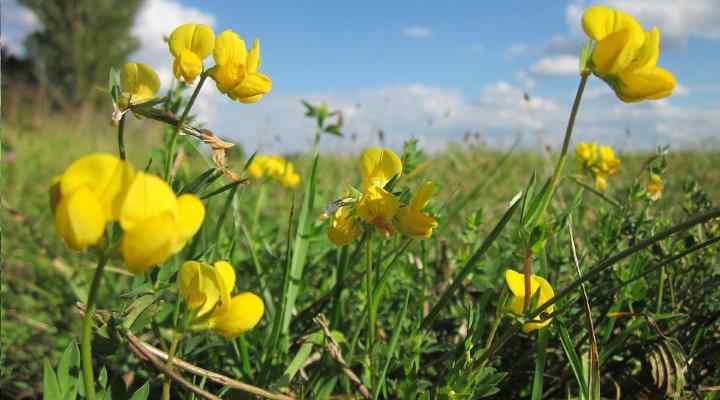
Birdsfoot trefoil is a fast growing lawn and grass weed with small yellow pea-like flowers
Birdsfoot trefoil is a fast-growing grass weed with yellow flowers that easily invades under-fertilized lawns. Birdsfoot trefoil is identified by its five-petalled brightly colored pea-like yellow flowers, small lanceolate leaves growing in groups of three, and green seed pods that resemble a bird’s foot. The tiny yellow flowers grow in clusters of two to eight.
Birdsfoot trefoil forms dense patches of large yellow-flowering foliage clusters in lawns with short grass blades. The fast-growing lawn weed grows 2” to 8” (5 – 20 cm) tall and wide. It’s difficult to eradicate from lawns because it withstands mowing and thrives in full sun.
How to control birdsfoot trefoil
The best way to control birdsfoot trefoil from becoming a pesky weed in gardens is to grow thick, dense turfgrass and not mow the grass shorter than 3.5” to 4” (9 – 10 cm) tall.
Black Medic (Medicago lupulina)
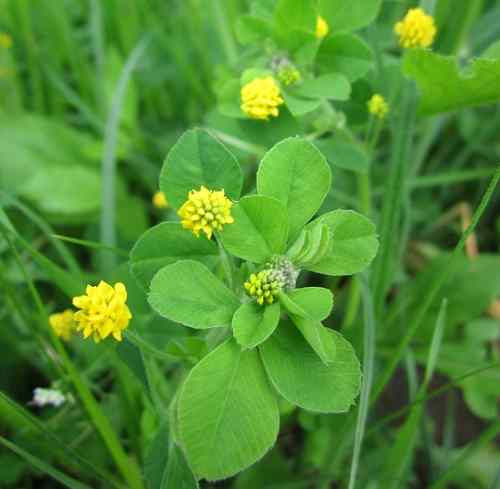
Black medic weed has small yellow flower heads and clover-like leaves that emerge from the grass
Also called yellow trefoil, black medic is a noxious summer annual weed with small yellow flowers and dark green clover-like leaves. The rounded yellow flower clusters consist of up to 50 tiny flowers that bloom throughout the growing season. The small spoon-shaped green leaves grow in groups of three and measure 0.75” (2 cm) long.
Black medic thrives in lawns and can choke out weak grass. Therefore, finding this yellow-flowering weed is often a sign of low nitrogen levels in the ground. Although this weed typically grows as a cool season annual, it can become a perennial weed in warmer regions.
How to control black medic
The best control method for black medic is to ensure you have a healthy lawn. For example, using a nitrogen-rich fertilizer could help to improve turfgrass health. It is also easy to hand-pull individual plants from moist soil. However, suppose there is a large infestation of black medic on a lawn. In that case, you may need to apply a post-emergent herbicide in spring and early fall.
Capeweed (Arctotheca calendula)
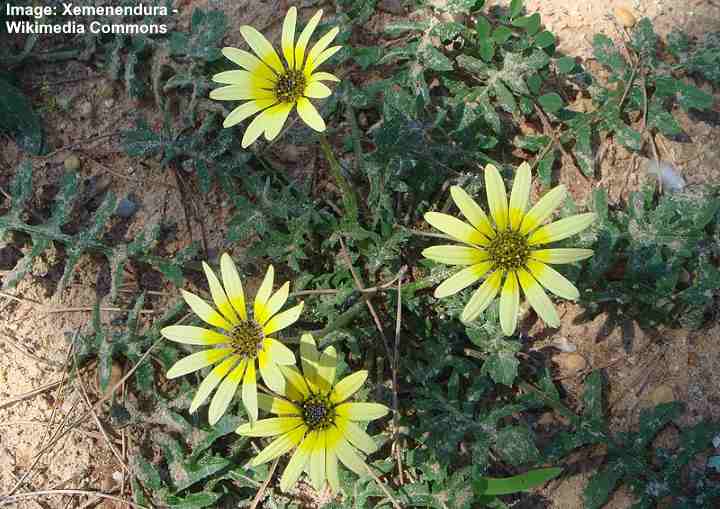
The yellow flowering capeweed grows low and close to the grass with rosette patterned lobed leaves
Capeweed is an annual, cool-season broadleaf weed with bright yellow petals forming a ray disk. This weedy lawn plant grows close to the ground and forms flat clumps of leaves in a rosette pattern. The leaves have a light green color on the top and a silvery-white color on the downy underside. They have lobed margins and slight serrations.
Capeweed is a short-stemmed grass weed that grows 12” (30 cm) tall and 30” (80 cm) wide. The pesky yellow weed spreads by seed; therefore, removing the plant by hand before flowering is crucial to control its growth.
How to control
It is easy to hand-weed capeweed to get rid of the invasive stems and yellow flowers from a lawn. In addition, regular mowing can help prevent the weed from producing seed heads. However, when the plant is most active in summer, flowering stems can appear every other day.
Common Sowthistle (Sonchus oleraceus)

Common sowthistle self seeds easily and becomes a lawn weed with small daisy-like flowers
Common sowthistle is an annual lawn weed with bright yellow daisy-like flowers growing on purplish hollow stems. A characteristic of most thistle weeds is their deeply lobed jagged leaves. These grow in a flat basal rosette in turf, spoiling the appearance of an entire lawn. After flowering, fluffy seed balls appear, with up to 8,000 seeds per head.
Common sowthistle grows 8” to 60” (20 – 45 cm) tall. The yellow flower heads are clusters of narrow petals that form a disk measuring 0.6” (1.5 cm) across. Although the lawn weed has a deep taproot, it only spreads via seeds; therefore, removing flowers before they seed is crucial.
How to control common sowthistle
Like most lawn weeds with a central taproot, hand removal of the entire root system is the only way to remove the weed entirely. However, regular mowing can prevent the spiky weed from growing tall stems.
Yellow Sweetclover (Melilotus officinalis)
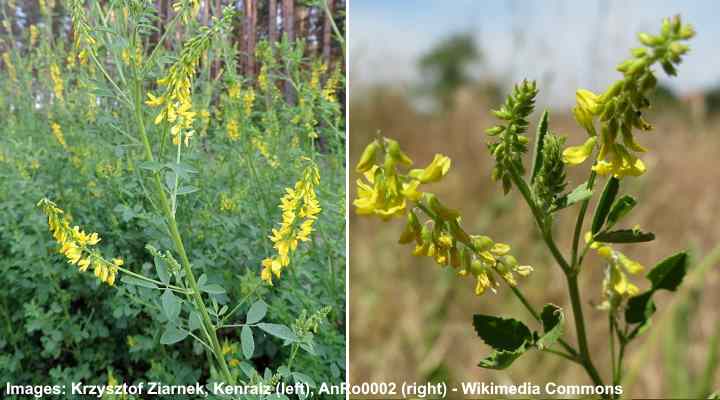
Yellow sweetclover is an invasive weed with tall yellow flower spikes
Yellow sweetclover is a problematic garden weed that can sometimes infest grassy areas and flower beds. The identifying features of yellow sweetclover are its flowering spikes with clusters of small yellow pea-like flowers, leaves growing in groups of three, and small pods containing oval seeds.
Due to its invasive nature and fast growth, yellow sweetclover is considered a weed. The plant’s seeds can lay dormant for 30 years before germinating. This causes the plant to grow where it’s not wanted—typical of all lawn weeds.
How to control yellow sweetclover
The best way to get rid of this irritating weed is to pull it up by hand and destroy it.
Related articles:
